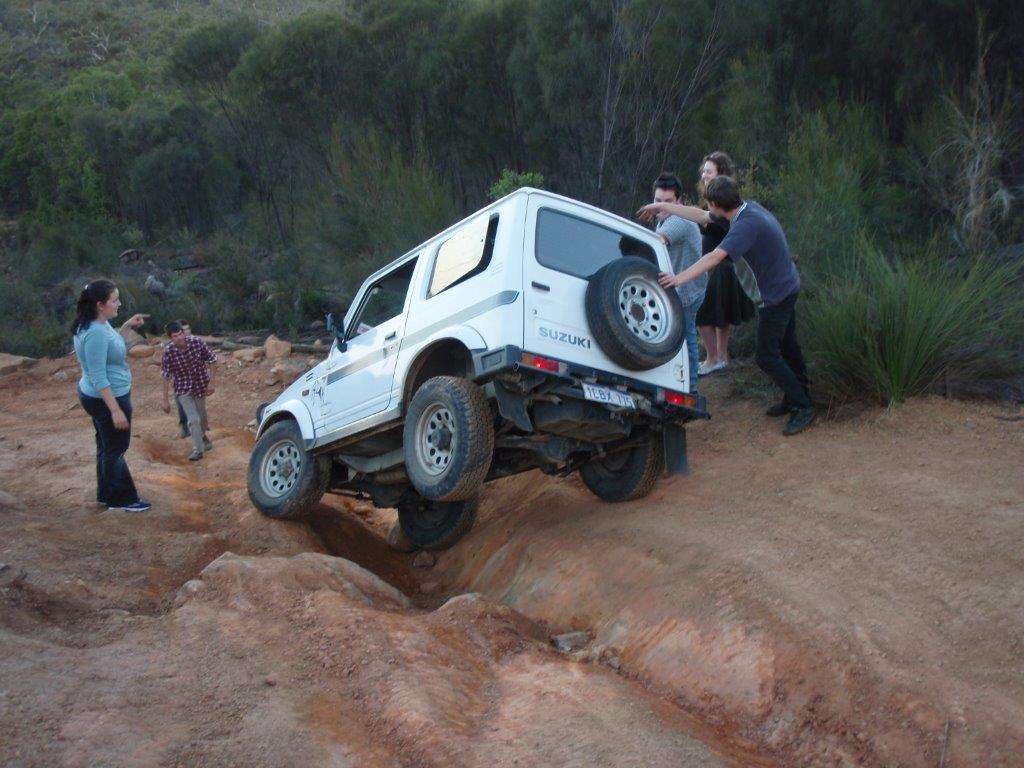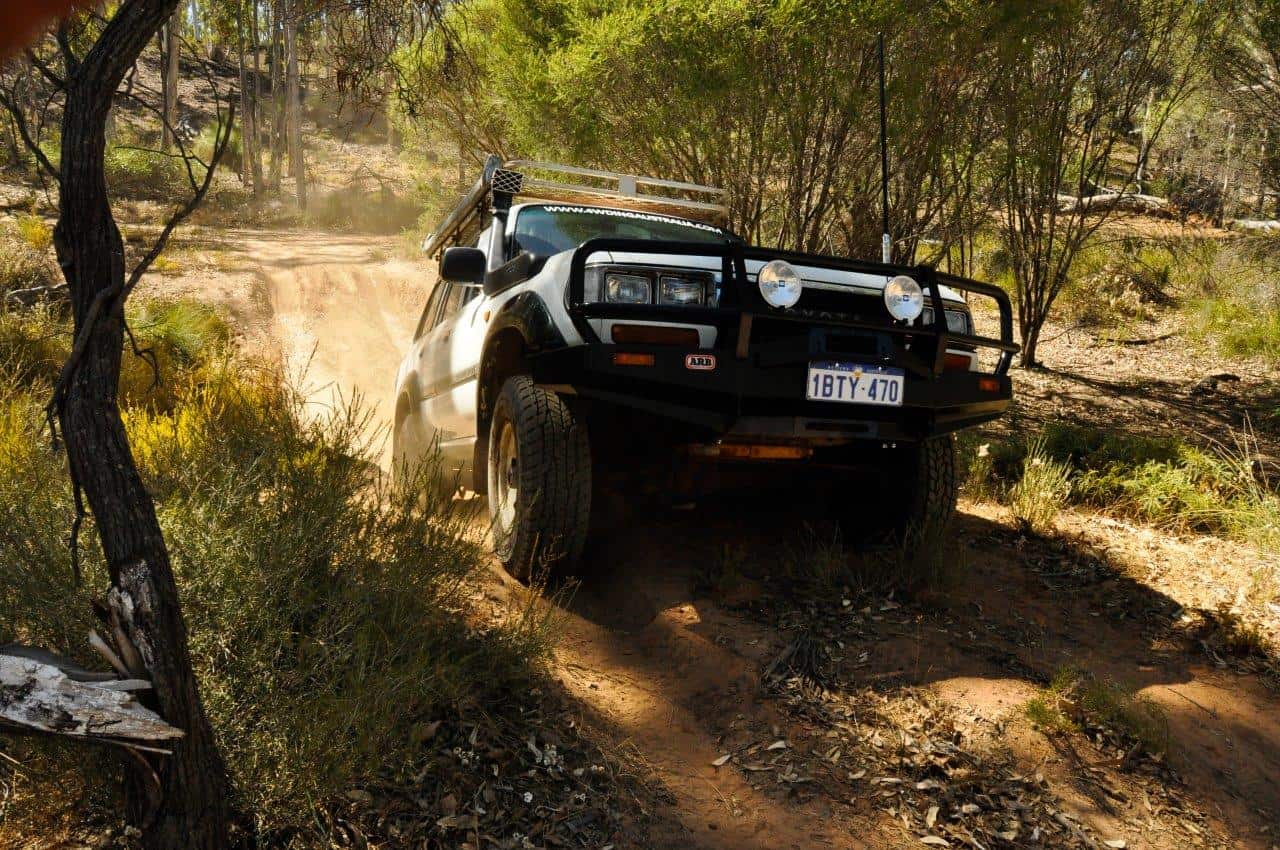How to recover a bogged 4WD, and what to think about
When you go 4WDing you soon learn that no matter where you are heading, there is a chance you may get stuck.
Even those that have spent hundreds of hours behind the wheel of a 4WD get stuck from time to time; it’s just part of the game. If you want to see some of the times we’ve been bogged, check this out – Have you been bogged before?
However, accept that it’s not the end of the world; you can recover your vehicle without any damage and be on your way in no time, if you do it correctly. Whether you are bogged in sand, or mud, or water, or just bottomed out on a rock there are plenty of ways to get moving again.
I have to mention your safety first though, as there have been a heap of people killed from 4WD recoveries in Australia that have gone very bad. Here’s a great post about things you shouldn’t ever do; 20 things you should never do in a 4WD recovery.

Prepare your vehicle so you don’t get bogged in the first place
They say prevention is better than cure, and if you can avoid getting bogged then it’s worth it. Believe me; I’ve spent hours on a shovel trying to get a stuck 4WD moving again, and it’s not fun!
Take the time to adjust your tyre pressures, walk the hill climbs and crossings and think about the lines that you take. It’s much easier to turn around or pick a different track than get stuck in the middle of a giant puddle and have to drive home with a 4WD half full of water!

The most common reason for people getting bogged is not having the right tyre pressures for the terrain they are driving on.
I’ve lost count of the number of people stuck close to a rising tide on the beach without the right tyre pressures. If you don’t take the time to set your 4WD up before you hit the bush, you increase your chance of getting stuck several fold.
The second most common reason is people attempting tracks that are too difficult for their 4WD. Know what your 4WD can do, and don’t push the limits without backup.
Make sure you have rated recovery points
You shouldn’t be heading off road without at least one rated recovery point on the front and the rear of your 4WD. Trying to recover a 4WD without rated recovery points can be dangerous and easily results in damage to the vehicle.
If you have a tow bar on the rear, you can purchase a recovery hitch point for about $50. For the front, you can either buy rated hooks or plate that a shackle attaches to. If you want more information, have a look at the post I wrote; Rated Recovery Points.
If you have a stuck hitch, you’ll have to get it out before you can install one.

If you do get bogged, what should you do?
Relax, and think it through
The first thing you should do is take a breath, and consider the situation you are in. The biggest mistake people make when they are dealing with a bogged car is rushing to get out of the situation. Some people put it in gear and flatten it, burying their vehicle and making it ten times harder for themselves.
Others rush and end up performing a dangerous recovery that puts people’s lives at risk.

Unless you have water coming into your vehicle, you have time to stop and think about what your options are. Even if water is rushing in, just remember your 4WD is worth a lot less than the damage you could cause to someone if your recovery goes pear shaped.
In every situation, there are a handful of different ways you can recover a bogged 4WD. You could lower the tyre pressures, dig a little, use traction aids, use a snatch strap or winch or just try to idle out of the situation. Rushing creates a panicked environment, and safety often goes out of the window.
Safety must come first
There have been a significant number of people killed and seriously injured from 4WD recoveries gone wrong.
Whether it’s a snatch strap breaking, a tow ball flying off (NEVER USE TOW BALLS FOR RECOVERIES!), a bull bar being ripped off or something else letting go, you don’t want to be responsible for someone getting hurt or killed.
I’ll say that again; Tow balls in 4WD recoveries can kill you.
Make sure during any recovery any bystanders are at least twice the length of your snatch strap or winch cable away. Use dampeners, rated recovery points and don’t stress your recovery gear beyond what it was designed for.

No momentum? Stop Driving!
One of the most common reactions to getting bogged in mud or sand is for the driver to throw it in gear and stomp on the go pedal.
If you aren’t moving forward and you make your tyres turn, the only direction you are going to go is down. The more you spin the tyres, the further down you go and the harder your recovery is going to be. Get out of the car and come up with a productive plan.

Work out why you got bogged
In order to get moving again, it’s vital that you understand why you got bogged in the first place. This can happen due to a number of reasons, and its hugely important for how to get unbogged:
You have bottomed out
One of the more common ways to get stuck in a 4WD is to bottom out. Most 4WD tracks have ruts, which are channels worn on either side of the vehicle where the tyres run.
If the ruts are deeper than the clearance that your 4WD has, you are going to get stuck. You can bottom out on rocks or tree stumps too, but the most common place to bottom out is in ruts.

Your haven’t got enough traction
4WD tyres play a very important role. They are the only contact point between your 4WD and the ground, and if they aren’t gripping well then you aren’t going to be moving anywhere. A loss of traction results in the wheels turning and you staying in the same spot.
Usually this means you start to sink, so stop driving! If you bottom out, then you aren’t going to be moving forward any time soon.

A lack of traction can occur because all 4 wheels are not being driven too. The engines power in a 4WD is sent 50/50 to the front and rear differentials.
From there, the power will go to each wheel equally if they have the same resistance. However, the power distribution across an axle is a little different; it will always take the line of least resistance. This means if you have a wheel (or 2 on separate axles) taking no weight, your power goes to the wheels that aren’t going to make your 4WD move.
You have broken something
Every now and again something will break under a 4WD. If you snap an axle or a CV, your vehicle will no longer drive all 4 wheels.
If you hear a noise before you get stuck, you’ve most likely done damage to the vehicle. This is not very common, unless you are doing serious four wheel driving where the vehicle is under significant stress.
How do you recover the bogged 4WD?
I mentioned above that every situation can have a hand full of different ways to be recovered, and as you 4WD more you will pick them up. However, for the above scenarios:

Bottomed out
If you are bottomed out, you should check your tyre pressures are correct for the terrain you are driving and deflate them as required. From there, you can:
Use a shovel to dig some dirt away and try to drive out. Make sure you accelerate slowly, and get the wheels just turning gently. If no forward progress is made, stop spinning the wheels and re-think your plan.
Use traction aids (like Maxtrax) under the wheels to improve the traction. These work by digging of the sand/mud/snow out of the way, and wedging them under the wheels. When you drive, they are sucted under the tyres and pop the 4WD up on top of the terrain.
Use a winch (if you have one) to a tree or another vehicle.
Have another vehicle pull you out with a snatch strap.
No traction
The most common reason for having no traction is running the wrong tyre pressures. If you are on sand, you can let your tyres down to 6 PSI if you have to, just to get your vehicle moving again.
Once you are moving again, pump them back up to 15 PSI. Again, make sure you take off slowly; you don’t want to spin the wheels rapidly or you may just sink further. If you still need more traction after correcting your tyre pressures, you can:
Use traction aids, like logs, maxtrax, shadecloth, carpet etc. Anything that is going to aid lifting your vehicle up and back onto the surface of the terrain will help.
Engage differential locks or traction control. These make a massive difference; if you have them, put them to use!
If neither of the above work, you need to use a winch or snatch strap to get you out of trouble.

Broken parts
If you’ve heard the dreaded ‘crack’ when off road, you know something has gone wrong. What you do next depends on a number of factors; the 4WD you are in, where you are stuck, how much room you have to work, what is likely to have broken etc.
In some cases, you can remove a component and then get recovered, but it’s almost always the end of your 4WD trip. You want to get the 4WD back to civilisation with as little driving as possible

Overview
Hopefully the above has given you some ideas of what to do should you get stuck in your 4WD. The most important thing to remember is that there’s no need to rush; you can get your 4WD out with no damage (except your pride maybe!) and live to tell the story.
Have you been bogged before? Let us know how you got out of it!






